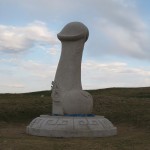Neo-Paganism is a nature religion which, like other nature religions, perceives nature as both sacred and interconnected. From this perspective, humans in the developed world have become tragically disconnected from nature, which has been desacralized in both thought and deed. Healing this rift is possible only through a profound shift in our collective consciousness. This constellation of ideas can be called “Deep Ecology”. This is the fifth in a 5-part series about some of “fruits” of Deep Ecology. This essay was originally published at Neo-Paganism.com.

In his essay, “Eskimo Science”, Richard Nelson writes:
“Probably no society has been so deeply alienated as ours from the community of nature, has view the natural world from a greater distance of mind, has lapsed into a murkier comprehension of its connections with the sustaining environment. Because of this, we have great difficulty understanding our rootedness to earth, our affinities with nonhuman life.”
The simple answer is: Spend time in nature — the wilder the better. It is well known that spending time in nature increases our health, vitality, and sense of well-being. Some researchers have linked obesity, ADHD, and other childhood health conditions to a disconnection from nature (what Richard Louv calls “nature-deficit disorder”).
You may have had an experience of awe from contemplating the vastness of the world or the cosmos when visiting the Grand Canyon or staring up into a starry night. Or you might have been captured by the infinitesimal complexity of nature when examining the veins on a green leaf or watching insects at work. Some people have even had mystical experiences of timelessness and dissolution of the ego in natural settings, when the boundaries between one’s self and the world are blurred. These experiences have the potential to transform our consciousness of ourselves and our relation to the world from one of separateness and superiority to one of participation and interconnectedness (what deep ecologists call the “ecological self”).
“Connecting with nature” is something of a misnomer, because it implies that we ourselves are not part of nature. But while this may be true on one level, on an experiential level, it is common for modern human beings to feel “disconnected” from our nature. “Connecting with nature” then is a basic part of Neo-Pagan practice. Doreen Valiente, the mother of Neo-Pagan witchcraft explains that what Neo-Pagans seek for in celebrating the Wheel of the Year is:
“a sense of oneness with Nature, and the exhilaration which comes from contact with the One Universal Life. People today need this because they are aware of the tendency of modern life to cut them off from their kinship with the world of living Nature, until their own individuality is processed away, and they begin to feel as if they are just another cog in a huge, senseless machine. It is the reaction against this feeling which is attracting people’s interest in [Neo-Paganism] today. They want to get back to Nature, and be human beings again, as She intended them to be.”
The Neo-Pagan Wheel of the Year consists of eight seasonal celebrations which correspond to the solstices and equinoxes and the seasonal points in between. The Wheel of the Year is a year-long spiritual meditation on the rhythms of nature and the corresponding rise and fall, ebb and flow of our inner lives.
The celebration of the Wheel of the Year is just one way of connecting with nature. Many Neo-Pagan employs ritual to help restore the sense of connection to the natural world. Neo-Pagan rituals use stylized actions, mytho-poetic language, and evocative imagery, including invocations of deities, recitations of myths, and sacramental acts, like lighting candles, libations, etc., which are all imbued with a sense of mystery and the sacred.
But connecting with nature need not always be so complicated. Just go outside and be present to your surroundings: earth, sky, air, sun, birds, etc. Use all your senses. Stretch your senses to increase your awareness of your environment. Doing this will deepen your sense of place and your feeling of connectedness with the world around you. Many people find that this practice is more efficacious in so-called “wild nature”, but it can be practiced in urban settings as well.
Below are several ways that you can develop a better connection with your natural environment:
- Sense meditation: Go outside and meditate on the world in your immediate environment. Focus on being fully present in the moment. Examine specific aspects of the environment in detail. Use all of your senses including sight, hearing, touch, smell, taste, and what Eugene Gendlin calls “felt sense”, the tacit internal bodily awareness.
- The sit spot: Go out to a place in nature and sit there. Sit and observe. Do this every day or once a week for a year so you experience the place in different conditions and as the seasons change.
- Sitting out or Setton sitting: Find a place in nature and sit very still and quiet until the wildlife forgets that you are there.
- Wander: Go for a walk without a plan. Be open to whatever you see, hear, and feel. Explore. Get lost.
- Journal: Write down what you experience when you are in nature. Draw pictures of the plants and animals around you. Record the changes in the weather.
- Bushcraft/Forage: Learn how to live off the land. Learn what plants grow around you, and what is edible or medicinal. Go out to the hedgerows, fields, and forests. Gather edible plants responsibly and make a meal.
- Thanksgiving: Give thanks before every meal. Acknowledge that what you are eating is a gift of nature.
- Eat seasonably and locally: Learn what grows in your area in each season. This is a good way to connect with the changing of the seasons.
- Garden: Grow our own food. Getting your hands dirty helps to connect us with the earth in a profound way.
- Compost: Watch your organic waste turn slowly into usable soil. Composting can be a kind of extended meditation on the transformative power of nature. The actress Bette Midler has said this about her experience with composting: “All my life I had waited for an inspiration, a manifestation of God, some kind of a transcendent, magic experience that could show me my place in the universe. This experience I made with my first compost.”
Another good place to start is to learn where you are at:
- What type of ecosystem or bioregion do you live in?
- What geological events influence the land in your area?
- What are some of the indigenous flora and fauna?
- What species have become extinct?
- What are some of the major weather patterns of your area?
- How long is your growing season?
- How much precipitation does your area receive annually?
- How is the land in your area used?
- Where is the “wilderness” in your area?
- Where does your water come from? Where does your food come from?
- Where does your garbage go?
- Where does your electric power come from?
- What are the major sources of pollution?
Recommended Links:















